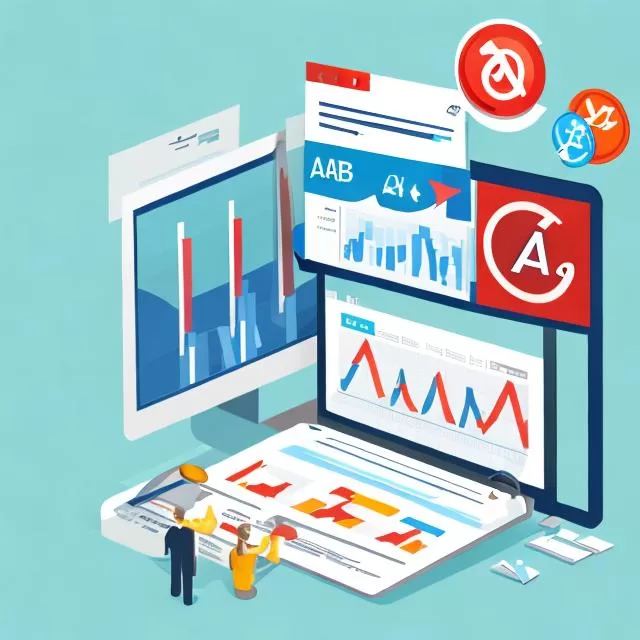A/B Testing - The Secret Weapon of Marketing and Advertising
Updated on March 4, 2025 by Tim Donahue
Comparing Version ‘A’ and Version ‘B’: Commonly Known as A/B Testing
If you’re running an online business and you’re not already acquainted with A/B testing, let’s help you learn all about this important marketing trick. This method is a must-have strategy for optimizing your marketing operations from email to ads to landing pages, sales funnels and much more.

Table of Contents
- Demystifying A/B Testing: What It Is and How It Works
- A/B Testing and Marketing: A Match Made in Heaven
- Setting Realistic A/B Testing Goals
- Blueprint for A/B Test Design
- The Nitty-Gritty: How to Conduct A/B Tests
- Interpreting the Numbers: Reading A/B Test Results
- A/B Testing Case Studies: Successes and Lessons
Demystifying A/B Testing: What It Is and How It Works
So, what is A/B testing? In simple terms, it’s a method where you compare two versions of something to figure out which performs better with your audience.
A/B testing isn’t rocket science. You take ‘A,’ your current approach, and ‘B,’ a slight variation, then see which one outperforms the other. Easy, right?
However, the methodology behind how to A/B test effectively is crucial. A poorly executed test can lead to skewed data and incorrect conclusions.
A/B Testing and Marketing: A Match Made in Heaven
A/B testing in the realm of marketing isn’t a new concept, but it’s one that’s often underutilized. How does A/B testing work in marketing? Let’s dig in.
With A/B testing, you can tweak almost anything in your campaigns, from email subject lines to the color of your call-to-action buttons. Then you test these changes to see which ones improve your conversion rates.
For instance, imagine you’ve got an email campaign. By using A/B testing, you can send two different headlines to two subsets of your audience and see which one gets more opens.
Setting Realistic A/B Testing Goals
Just deciding to do A/B testing isn’t enough. You’ll need goals to measure your success.
When setting goals, make them SMART: Specific, Measurable, Achievable, Relevant, and Time-bound.
For example, don’t just say, “I want more sales.” Instead, aim for something like “I want to increase sales of product X by 10% in the next 30 days.” or “I want to increase click through rates of my ads from my last campaign.” etc.
How To Design An A/B Test
So, how do you design an A/B test? Start by identifying a variable to test; this could be a headline, image, a call to action, or even a button color.
Next, create a ‘control’ and a ‘test’ group. The control group sees the current version (‘A’), and the test group sees the new version (‘B’).
( Note: When you’re running online ads via Google or Facebook, you don’t choose a control or a test group. Google or Facebooks serves an equal number of each of your A and B ads so you can see which performed best by reviewing each ads’ analytics. )
Make sure that your test group is large enough to provide statistically significant results. Even a group of a 20 or 30 is OK to begin with though, but the bigger the group the better. There are online calculators that can help with this.
The Nitty-Gritty: How to Conduct A/B Tests
Once your design is ready, it’s time to test. But how to conduct A/B testing in a way that brings value?
For instance, if you’re testing an email campaign, take an email list of your prospects and split it directly in half. First half and second half.
Now, send version A to half your list and version B to the other half. Track metrics like open rate, click-through rate, and conversion rate.
Tools like Optimizely can help automate this process and even integrate with your existing marketing software.
Interpreting the Numbers: Reading A/B Test Results
You’ve conducted your A/B test, and now it’s time to read the results. What should you be looking at?
Check the metrics you initially set goals for. If you’re using a email list provider like Mail Chimp, there will be stats available for each campaign you send.
If you’re using online ads, Google and Facebook also provide robust stats for your campaigns.
Now take a close look at those stats: Was there a statistically significant difference in performance between A and B?
If so, you’ve got a winner! If not, go back to the drawing board. But remember, not every A/B test will produce earth-shattering results.
A/B Testing Case Studies: Successes and Lessons
Real-world A/B testing examples can provide valuable insights. One classic case involved changing the color of a button on a landing page, resulting in a 21% increase in conversions.
Another example is from the email marketing realm. A company tested two different email formats and found that a simpler design led to a higher engagement rate.
What’s the lesson here? Sometimes small changes can make a big impact, but you won’t know unless you test.
The Real Magic: Choose the Best Ad, and Test Variations To Make It Perform Even Better
This is the real magic of A/B testing:
The idea is to take the best performing ad, and create some variations of it to see if you can get it to perform even better than last time. Keep repeating, or iterating this process to create a high performing ad.
You do this over and over again until you max out the ads effectiveness. It’s like breeding a champion race horse. You iterate your ads over and over, each time improving the ad performance, via A/B testing.
A/B Testing with Facebook Ad Manager: A Step-By-Step Guide
Think A/B testing is only for your website or emails? Think again. Facebook Ad Manager is a playground for A/B testers, and it’s incredibly user-friendly. Let’s walk through how you can get the most bang for your buck with your Facebook ads.
1. Setting Up a Multi-Ad Campaign
Start by launching a new ad campaign in Facebook Ad Manager. Instead of just creating one ad, go all out and make four different versions. Yep, that’s right—four. This essentially kicks off a 4-way A/B test right out of the gate.
You can experiment with different headlines, images, or even target audiences. The aim is to get a broad sense of what’s resonating with people.
2. Let ‘Em Run
After setting up your 4-ad campaign, let it run for about a week or 10 days. Patience is a virtue; this gives Facebook’s algorithm enough time to spread your ads around and get you some juicy data.
3. Analyzing the Results
Once your campaign has had its run, head back to the Ad Manager to see how each ad performed. Metrics like click-through rate, engagement, and conversion rate will be your best pals here.
Identify the winning ad—this is your new golden child.
4. Round Two: Fight!
Take your winning ad and create several other versions of it, but—and this is crucial—change only one thing in each new version. Could be the headline, the image, or even the call-to-action button.
Guess what you’re doing next? Yep, another 4-way A/B test with these new variations. Run this campaign just like the first one.
5. What Exactly Are You Testing?
Oh, the possibilities! You can test imagery types (still image vs. video vs. animation), marketing messages, specific words or phrases, colors, and much more.
The key is to make sure you’re changing only one variable at a time. This way, you know exactly what’s causing the uptick (or downturn) in performance.
Conclusion
A/B testing is an invaluable tool for any online business owner. From fine-tuning your marketing campaigns to optimizing your sales funnels, the possibilities are endless.
Understanding what is A/B testing and how to A/B test effectively can give you the upper hand in this competitive digital landscape.
Ready to start A/B testing? Take the first step today. Your business will thank you.
